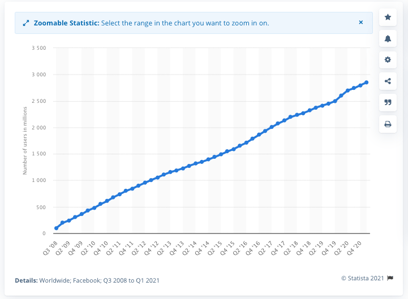
Today’s subject is a profile of Facebook PLAs (Product Listing Ads), which the company has now re-tooled to be known as Dynamic Product Ads, or DPAs. To avoid confusion in this article, we will mostly stick with the more familar PLA acronym.
Why every seller wants to use Facebook PLAs
Facebook, the mother of all social platforms, is an unstoppable powerhouse when it comes to effective reach in advertising. Just consider the growth trajectory and number of active daily users.

Source: Statista, 2021
Of those 2.7 billion users, roughly 2/3 of the US population is on Facebook every day, reading their news feeds and viewing ads. In this article we will take a closer look at Facebook PLAs, and how the platform has evolved its advertising strategies for businesses over the years.
2004: In the beginning, ads were seen in a very limited scope by the founders as a “way to pay for the servers.”
The social platform has actually been selling ads since Mark Zuckerberg’s college days, starting with small display or classified-type ads for local businesses catering to students. But the rush to monetize came quickly, and in 2007 Facebook officially launched its first dedicated Ads program.
2007: The first official version of Facebook Ads is introduced.
The first types of ads used by Facebook were called “Social Ads” — ones based on social actions from a user’s friends. You would see when someone you knew made a recent purchase or reviewed a business, together with an advertiser’s message.
This was their first foray into the now-familiar specific, targeted ads using the targets’ own social connections and Likes. Ads appeared in two places: the user’s news feeds, or in a dedicated space in the sidebar. There was still a “social connection” to the ads a user would see. But this left out a vast number of people whose friends might not happen to be such active or curious consumers. There were still loads of fat targets missing out on the Facebook product listing ads.
2011: Ads are placed directly into news feeds, no social connection necessary.
In that year, Facebook first introduced its “Sponsored Stories” project. This was the first time that paid advertisements were inserted directly on users’ news feeds. Initially, the company pledged to only show users just one sponsored story on their news feeds per day. Those stories also stemmed solely from friends or pages the users themselves had already engaged with. As Facebook realized the revenue potential from ads that could be placed directly instead of relying on social connections, the latter feature was eventually dropped. Some users bristled at the appearance of these ads, but advertisers loved it. They could display their ads directly in the mix of social content and consumers’ news feeds instead of seeing them segregated into a dedicated ad space over to the side.
2012: Facebook PLA launches its mobile ads program.
It’s hard to imagine now, but until 2012 Facebook’s mobile app didn’t actually generate any revenue to Facebook. But again, the monetization opportunity couldn’t be ignored.
Facebook’s strategy was to subtly and gradually introduce advertisements into users’ feeds. Its mobile ads strategy was based on the Sponsored Stories that had worked so well in the desktop version. They seamlessly blended paid promotional content into the news feed.
Still, Facebook aimed to make ads as discreet as possible. Real estate was limited on the page, and ad text had to be extremely brief.
2014: Facebook PLAS roll out with a new, 3-level ad campaign structure.
In that year, the company introduced new layers to its Facebook PLA structure. Until then, there had been only two layers: Campaigns, and individual PLAs. Campaigns let advertisers set a unifying theme – say, the Olympics, and individual ads promoted products related to that theme.
They designed Campaigns to help users optimize, and measure results of individual ads. But the new wrinkle introduced that year was called “Ad Sets.” Advertisers could set these to rotate, so users would not see the same ad repeating frequently in their news feeds.
2017 brought the latest version, still in use: Facebook DPAs (Dynamic Product Ads).
Facebook Dynamic Product Ads, or DPAs, advertise your product or service by lifting the images and data from your product listing feed, triggered by user actions. It displays it to customers who have looked at your website, your app, or anywhere else on the web where your brand is represented. Ads are specially formatted based on keyword terms searched or otherwise mentioned by the user.
The Shop Now feature on personalized Facebook ads creates a compelling CTA for driving traffic to your store, along with greater conversions. And you can customize the button yourself.
The Facebook platform now also provides actionable insights on creative, audience and optimization strategies.
Some of the metrics measured include
- ROI
- Engagement
- Cost per 1000 views
- Cost per transaction
Use Facebook PLAs for a number of different goals, from awareness and credentialing, to branding and marketing. Users can choose up to 3 images. Other advantageous features: these new dynamic ads support text overlays as well as lifestyle photography, letting you get especially creative with imagery.
Today, Facebook PLAs create a highly relevant marketing channel for your products. Dynamic Product ads let you target a whole category segment such as apparel, accessories, sporting goods, etc. Shoppers can opt to visit your educational page before they buy, or just buy directly by clicking on the Shop Now CTA.
As one of Shoppingfeed’s Channel Partners, Facebook PLAs are easy to access from our single, multi-channel dashboard.

We pre-set all of Facebook’s uniquely required product tagging and attributes for every product you list for DPAs. By taking away the guesswork and tedium of setting these manually yourself, we help our customers succeed in all their new channel ventures.




